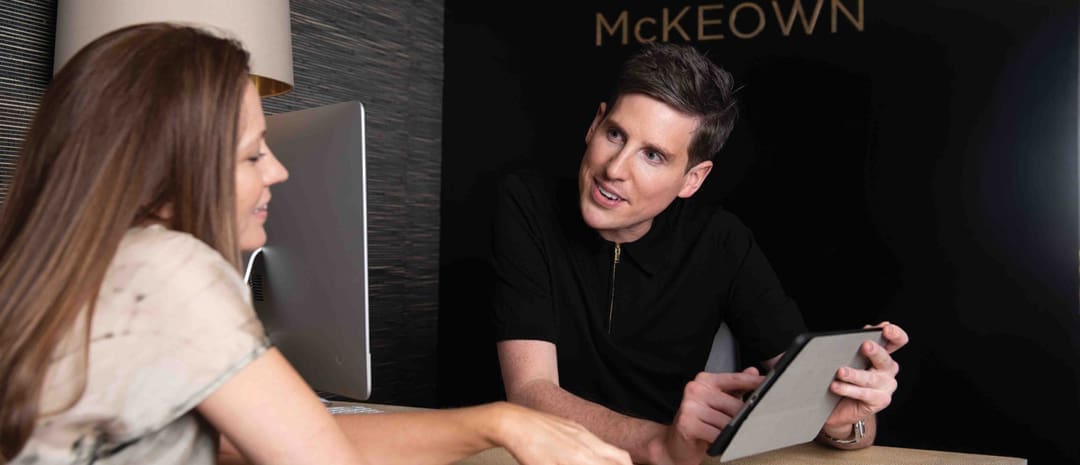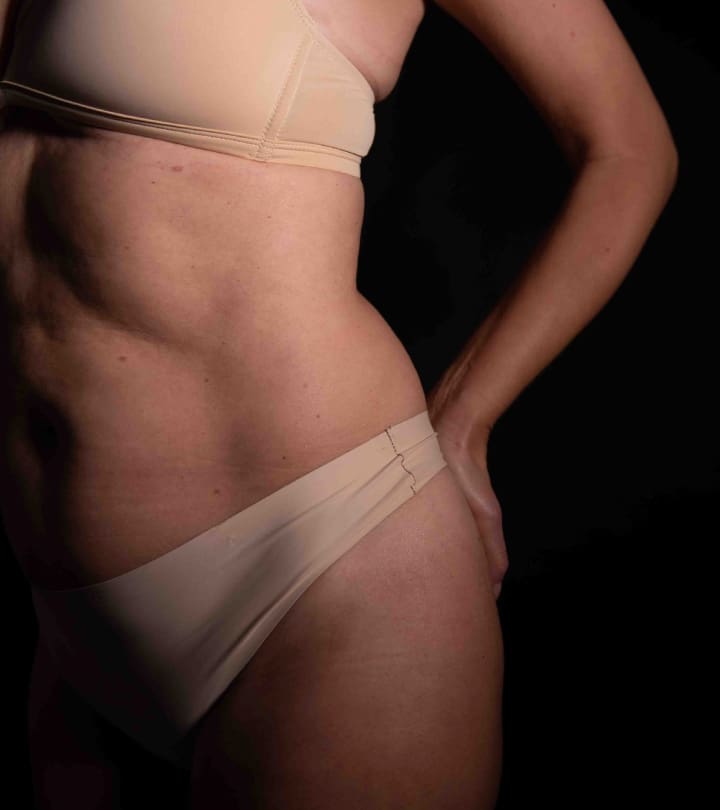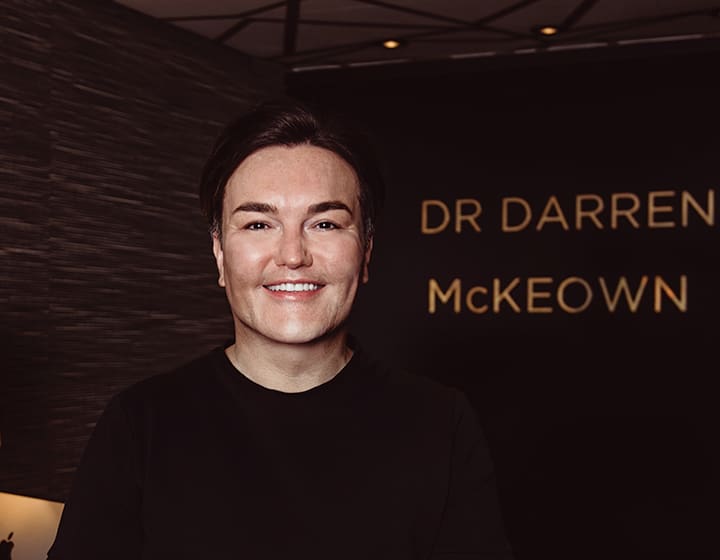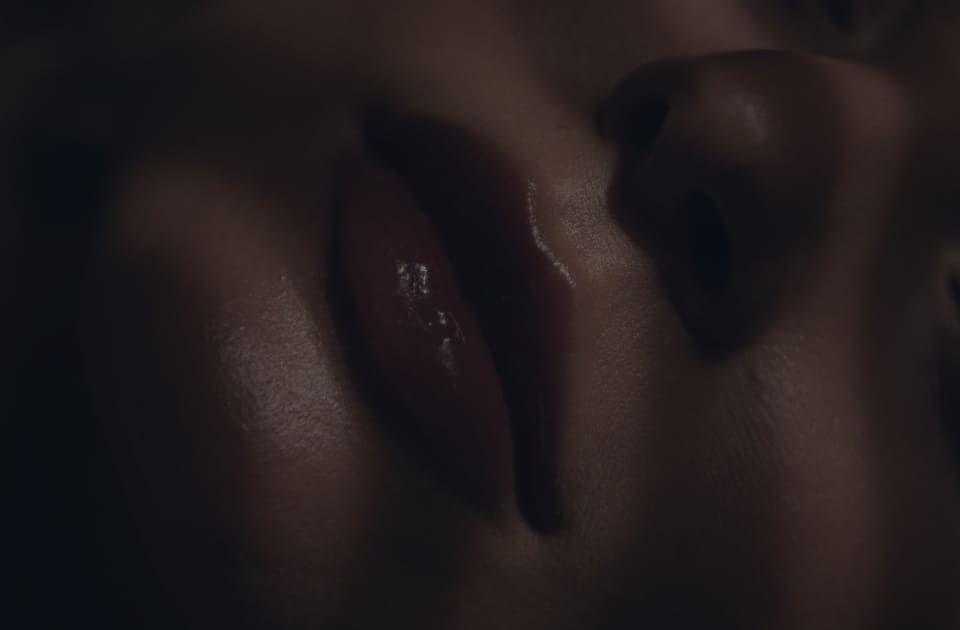McKeown Medical
167 Bath Street, Glasgow, G2 4SQ
Sun Damage, as the name suggests, is often the result of prolonged exposure to the sun. Chronic exposure to the sun’s harmful rays causes a number of changes to the skin, including sending the melanocyte cells into overdrive producing excessive amounts of melanin (the pigment which gives the appearance of a sun tan). While this protects the skin, it subsequently produces dark patches known as hyperpigmentation – a key sign of “sun damage” that is commonly found on the face, décolleté and backs of the hands – indeed, any area where the sun naturally hits. Fortunately, our expertise in treating pigmentation, in combination with the very best energy-based devices, enables us to effectively eradicate sun damage – resulting in more radiant skin on both the face and body.
Sun Damage, as the name suggests, is often the result of prolonged exposure to the sun. Chronic exposure to the sun’s harmful rays causes a number of changes to the skin, including sending the melanocyte cells into overdrive producing excessive amounts of melanin (the pigment which gives the appearance of a sun tan). While this protects the skin, it subsequently produces dark patches known as hyperpigmentation – a key sign of “sun damage” that is commonly found on the face, décolleté and backs of the hands – indeed, any area where the sun naturally hits. Fortunately, our expertise in treating pigmentation, in combination with the very best energy-based devices, enables us to effectively eradicate sun damage – resulting in more radiant skin on both the face and body.
A patient before and after treatment at McKeown Medical.
A patient before and after treatment at McKeown Medical.
A patient before and after treatment at McKeown Medical.
A patient before and after treatment at McKeown Medical.
Laser is the gold-standard technology in treating unwanted sun damage, and we use the Joule device from Sciton – the most sophisticated laser technology available. In the earlier stages of sun damage – or when a patient wants a treatment with no downtime – we typically use the BBL treatment alone. BBL is excellent for improving the complexion – clearing uneven pigmentation, getting rid of redness and broken blood vessels, as well as improving texture and pores.
BBL (BroadBand Light) is a treatment that treats a variety of skin issues including rosacea, pigmentation, acne, pores, texture and provides an overall improvement to the skin quality providing a healthy glow even to patients who don’t have a particular issue they want to treat. It’s the one treatment that almost everyone with ageing skin would benefit from.
An example of a patient before and after treatment with a combination of BBL and Halo.
An example of a patient before and after treatment with a combination of BBL and Halo.
An example of a patient before and after treatment with a combination of BBL and Halo.
An example of a patient before and after treatment with a combination of BBL and Halo.
An example of a patient before and after treatment with a combination of BBL and Halo.
An example of a patient before and after treatment with a combination of BBL and Halo.
An example of a patient before and after treatment with a combination of BBL and Halo.
An example of a patient before and after treatment with a combination of BBL and Halo.
When patients have more advanced sun damage and the pigmentation is deeper and especially when there are more texture issues, then we will also add in the Halo laser for additional resurfacing.
In this case we combined Halo with a BBL (Broad Band Light) treatment. Combining Halo with BBL also allowed us to target redness and pigmentation on the patient’s skin
Your treatment plan will be tailored to your individual needs and the results you are looking to achieve.
Finding the right treatment for you is the most important factor in ensuring that you are on the correct path to achieve the results you desire. Our pre-consultation enquiry helps us to identify your needs and, ultimately, gets you on the right path to achieving your optimal results.

This is one of our patients who wanted to reduce the effects that years of sun exposure had on her skin. Although she loved a tan when she was younger, she hated the impact it had on her skin as she got older. We used full field resurfacing to reduce the lines and wrinkles that had been etched into the skin by the sun. Hear how Donna got on with this treatment.
Hear from our patients about their experience at McKeown Medical.
1 / 13
2 / 13
3 / 13
4 / 13
5 / 13
6 / 13
7 / 13
8 / 13
9 / 13
10 / 13
11 / 13
12 / 13
13 / 13
From the moment I walked through the door I was treated so well by every member of staff, all so friendly and helpful. I received Halo and BBL I was a little nervous but Dr Rhona completely put my mind at rest.
After my treatments I was taken good care of and Dr Darren came and reassured me too which was an added bonus. I returned a few weeks later for my checkup and again was treated so well, Dr Darren remembered me which was lovely.
I am delighted with the results of my treatment I feel my skin looks so much fresher and this in turn has lifted my self esteem which had previously been at a low point. I highly recommend both these treatments and would not hesitate to return to Dr Darren’s Clinic in the future. Thank you to all again.
A McKeown Medical patient December 2023
It’s just a lovely clinic. Everyone is very professional and it feels very high end, so you know you’re in safe hands, but they’re also friendly, welcoming and warm which really matters when visiting as it helps you feel at ease & relaxed.
From my very first contact with yourselves to the minute I left the attention to detail and client service was impeccable, every member of staff I came into contact with was so friendly and professional put me at ease so much. Sometimes I get a little overwhelmed with environments like this however this was furthest from my thoughts on arrival.
My consultation answered all concerns Dr Rhona explained what would give me best results as to what I was looking to achieve . As I was travelling from a far your team kindly got my booked in same day for my treatment so I didn’t have to make another journey. Upon my procedure which again every step of the way was explained my therapist was so attentive talked me through everything step as she was carrying out my treatment and explained all my after care.
I am currently in day 3 of the Halo treatment and everything is exactly what I was told to expect. I am now looking forward to seeing end result. Thank you to you and your team .
A McKeown Medical patient May 2024
The best place for the best advice and the best service. Friendly, knowledgeable and professional.
A McKeown Medical patient November 2023
The whole experience was fabulous. My phone consultation was very knowledgeable and friendly and everyone in the office was so welcoming. I’ll definitely be back.
A McKeown Medical patient April 2024
I saw Dr Rhona Cameron who I have seen before. She is very welcoming and has a lovely manner. She is easy to talk to and I am very pleased with the results.
A McKeown Medical patient November 2023
Made me feel really calm and relaxed and staff from reception and treatment room were so pleasant and very professional.
Dr Darren was amazing. Made me so comfortable and so so pleasant. Such a lovely guy! Highly recommend, absolutely delighted so far – although, as advised, a bit swollen! Thank you so much.
A McKeown Medical patient April 2024
From start to finish the team and Dr Darren were so welcoming and professional. Everything was explained clearly and the results are more than I could have hoped for.
A McKeown Medical patient April 2024
I am delighted with the subtle changes that have made such a difference to my face giving me so much more confidence. Dr Darren is one of the very best so I had total trust in what he was doing. Every member of staff make you feel at ease, they are all so lovely and friendly.
A McKeown Medical patient March 2024
Dr Rhona was lovely and put me at ease before and during the treatment. I was well informed of my options prior to treatment taking place and aftercare was explained thoroughly too. Will definitely be revisiting soon.
A McKeown Medical patient March 2024
Dr Rhona was particularly kind and sensitive to my needs and her care is very patient centred.
A McKeown Medical patient October 2023
Lovely friendly staff. Came out after treatment feeling so much better about my appearance. Dr Darren McKeown puts you at ease and gives you a wonderful boost. Thank you all.
A McKeown Medical patient March 2024
I have so much trust and faith in Dr Darren and I thank him dearly for all that he has done for me to improve my confidence.
A McKeown Medical patient September 2023

Our bespoke laser treatments mean that we can effectively diminish the appearance of sun damage. It is vitally important that you do not come for a treatment if you have tanned skin, either real or fake, or if you have recently used any photosensitising medications (the most common of which are tetracycline antibiotics, a commonly prescribed acne suppressant).
We use cold air to cool the skin and provide a comforting sensation during the treatment, distracting from any heat generated as a by product of the treatment.
Following treatment, it is normal for the skin to be a little red, although this has usually calmed by the next day. Treated areas of sun damage will be noticeably darker within a few hours; however, these will start to fade a week or so later and will eventually flake off, revealing smooth new skin. It is advisable to keep the complexion clear of makeup and to use a mild skincare routine and a high SPF in the days following.
Your doctor will recommend a course of treatment based on your needs, with four weeks between each session. While best results are visible following completion of the course, you should be able to notice a progressive improvement after each session.

Our founder, Dr Darren McKeown, is renowned for his expertise and artistry with dermal fillers. As a peer-reviewed medical author, he is passionate about treatments that stand up to scientific scrutiny. Above all, Dr McKeown believes in a global approach; delivering flawless results – and rejuvenation that lasts.

Dr Rhona Cameron is a skilled injector who has been extensively trained in Dr McKeown’s signature intuitive technique. Her treatments blend advanced facial optimisation with powerful, energy-based devices – such as lasers, BBL and radio frequency – energising the appearance and enhancing skin health. approach; delivering flawless results – and rejuvenation that lasts.
1 / 2
2 / 2

Our founder, Dr Darren McKeown, is renowned for his expertise and artistry with dermal fillers. As a peer-reviewed medical author, he is passionate about treatments that stand up to scientific scrutiny. Above all, Dr McKeown believes in a global approach; delivering flawless results – and rejuvenation that lasts.

Dr Rhona Cameron is a skilled injector who has been extensively trained in Dr McKeown’s signature intuitive technique. Her treatments blend advanced facial optimisation with powerful, energy-based devices – such as lasers, BBL and radio frequency – energising the appearance and enhancing skin health. approach; delivering flawless results – and rejuvenation that lasts.
1 / 3
2 / 3
3 / 3
Keep up to date with the latest news from McKeown Medical and get access to expert insights, our latest before and afters and exclusive offers.

